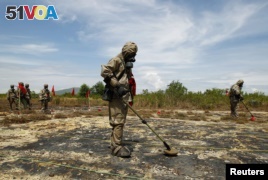February 21,2014
U.S. involvement in the Vietnam War was long and costly in many ways. The conflict itself raged for more than two decades, but the consequences of military actions taken in Vietnam continue to this day.

FILE - Soldiers detect Unexploded Ordnance (UXO) and defoliant Agent Orange in Vietnam's central Da Nang City.
Peter Sills, an attorney who helped represent the Vietnam Veterans of America in a class action lawsuit regarding the use of Agent Orange, has written about it in a new book titled Toxic War. Speaking with VOA’s Jim Stevenson, Sills told of the many ways Agent Orange had a direct effect on people, and how it even evolved into a weapon.
SILLS: The thing that surprised me the most, when the (U.S.) government found out people were scared of it (Agent Orange), they began spraying the Vietnamese people deliberately. Whether they knew they were poisoning them or not is a question I raise in my book. And there is evidence on both sides of that.
STEVENSON: So what you are asserting is at the very least unintentional chemical warfare.
SILLS: Yes, a chemical war. The U.S. government used chemicals that were not manufactured as weapons but they were used as weapons. That includes herbicides, riot control gasses. Napalm which is supposedly used to defoliate was modified to stick to human flesh. As we started to lose the war and become more desperate, we changed the tools we used to help in the war, we started to use them against people.
STEVENSON: How were American veterans at that time being exposed in harmful ways?
SILLS: When you start spraying towns and villages, there are American soldiers there too. That is part of it. The food that people ate became poisoned, and the water that people drank. There is another surprising thing: herbicides came in 50-gallon barrels. When they were emptied, they were not really empty. There were two or three gallons of herbicide left in the barrels. Soldiers used them for showers, for bar-b-ques (grills for cooking). Vietnamese used them to hold gasoline and wound up spraying dioxin all over Vietnam. The cities became defoliated even though they were never sprayed (from U.S. planes). They were sprayed by Vietnamese automobiles and motorcycles. No one could figure it out for a while. So people were exposed in surprising and unexpected ways.
STEVENSON: How many U.S. veterans are we talking about looking for some sort of compensation because of exposure to Agent Orange?
SILLS: Hundreds of thousands, possibly over a million. That is muddy unfortunately because there are so many people who are sick for reasons other than herbicide exposure. The symptoms of dioxin exposure, the poison in the herbicide, are not very different from what people get normally, heart attacks, diabetes, lung cancer, liver problems, neurological problems, things that people just get. So to determine whether they were actually exposed, it should be possible to do that. But the officially done science has not been able to do that.